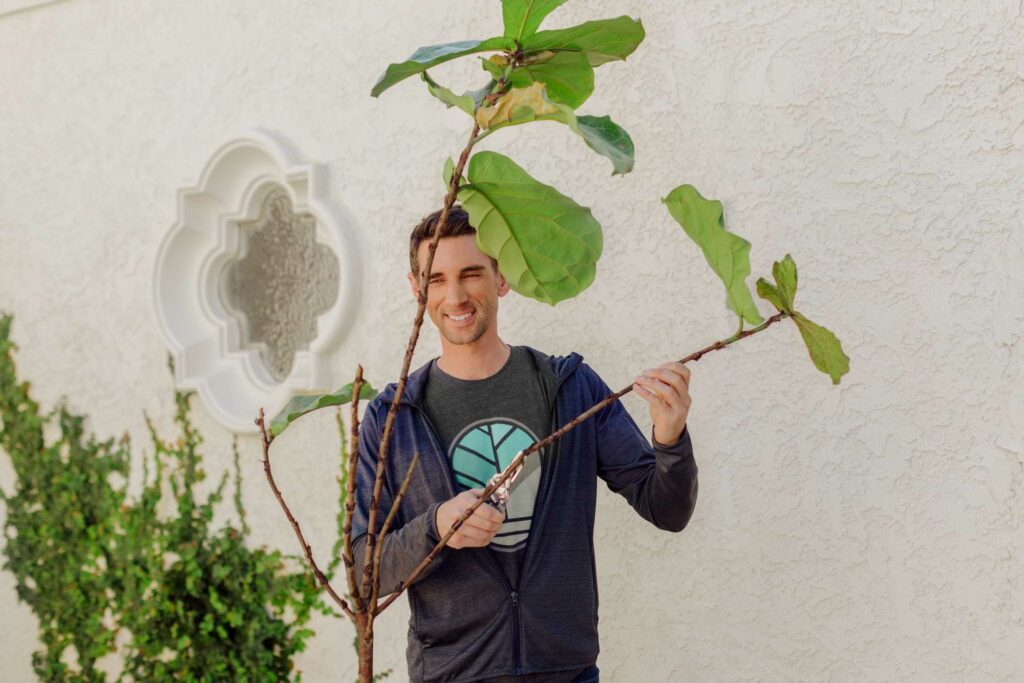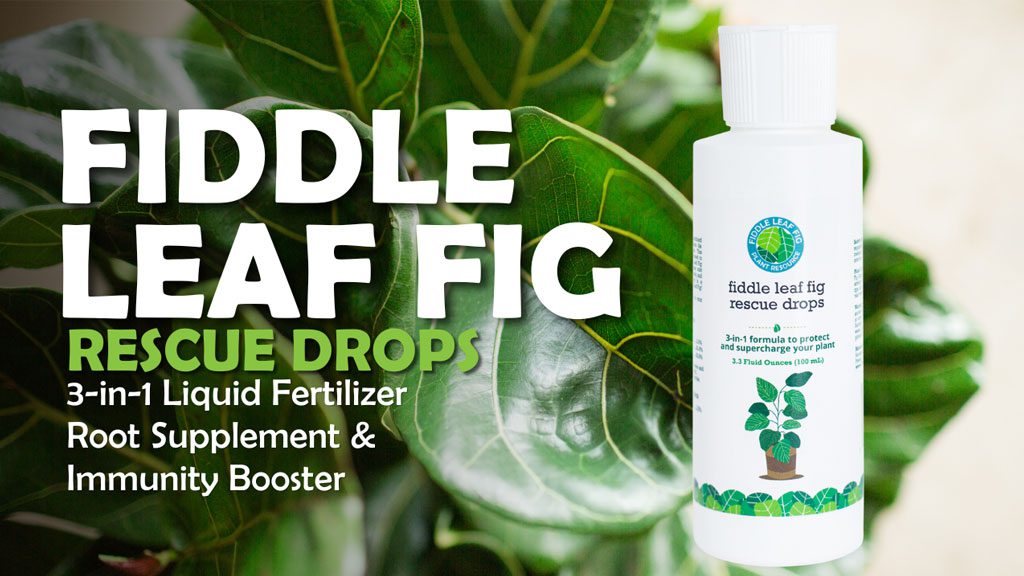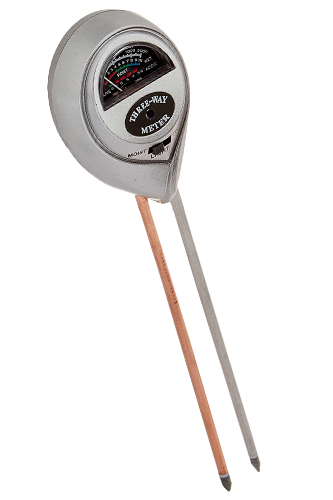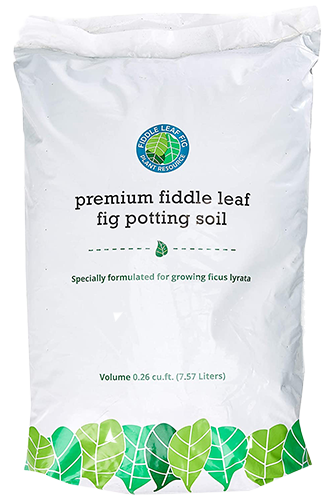Sunburn on your plant can happen quickly in a matter of minutes! Learn how to rehab a sunburned fiddle leaf fig tree.
Every houseplant lover began as a novice on their plant-loving journey, and we’ve nearly all encountered the fast and devastating harm that an extra sunny window can do to our plants.
We’re happy to collaborate with Jared and his photographer Matt of Jared’s Detours as Jared rehabs a stunning Fiddle Leaf Fig tree that declined quickly from getting too much direct sunlight that scorched most of its leaves. Sunburned fiddle leaf fig can occur quickly!
This beautiful FLF tree went from this:
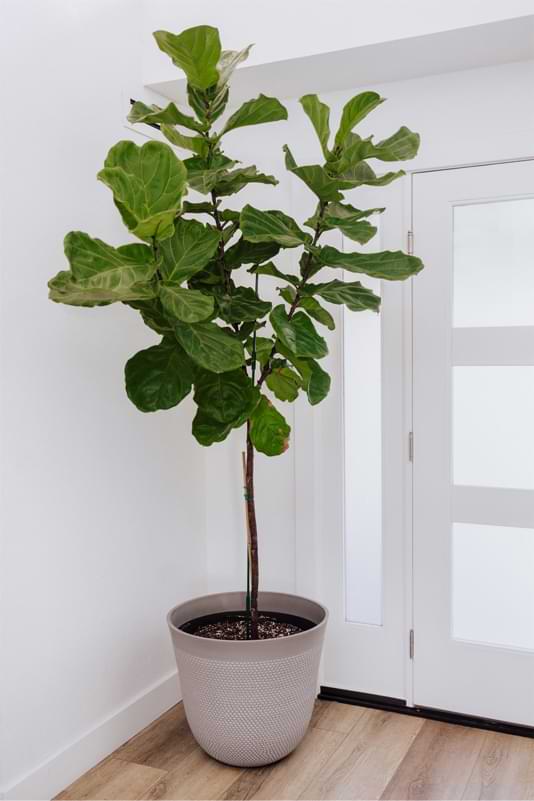
To this in just a couple of weeks. This is how a sunburned fiddle leaf fig can look.

Here’s Jared’s first-hand account of what happened, and how he’s working diligently to beat the odds against him in saving this tree:
It happened so quickly…
Sunburned Fiddle Leaf Fig Story Continued
The dry desert heat in the Phoenix area creates all kinds of challenges for gardeners. As I write this, the humidity is 16%, and it hasn’t rained in a month.
Still, we’re lucky to have a number of great garden centers and nurseries, since it’s warm enough year-round to be growing something outdoors (or making the attempt)!
One of the nurseries often gets truckloads of fiddle leaf fig trees. One year in a “Black Friday” sale, six-foot-tall fiddles were going for $20 each! What better gift is there!?
Over the summer, I thought I hit the jackpot, when the nursery announced: they were overstocked with fiddles!
They had a whole greenhouse full of eight-foot tall monster fiddles, with big bushy branches.
I already have five fiddle leaf fig trees, plus five more small ones I’ve grown from twigs and cuttings, so my space has reached its limit. (At least, that’s what I’ve been told.)
As luck would have it: my mother-in-law was about to celebrate a birthday! She loves plants, and has a greener thumb than I do, so I figured a beautiful tree would be the perfect gift.
We hauled the tree to her house, and she loved it!
She found the perfect pot and “the perfect spot” for the tree. It was the ideal leafy filler for a vacant corner in a big living room with a tall ceiling.
Then, she grew suspiciously quiet.
Unbeknownst to me, the leaves had begun to drop.
It started slowly, but escalated quickly. In less than two weeks, other family members had declared the entire tree a lost cause.
The entire family kept the carnage a secret from me, until the tree was essentially bare.
By the time I was allowed to inspect the damage myself, the tree had turned into the fiddle version of Charlie Brown’s Christmas Tree.

It had a leaf or two left on each limb, and the survivors were barely clinging to life.
The Arizona summer sun, though filtered through a window, was too much for this fiddle. Like most of the trees at the nursery, it was grown in ideal conditions, and quickly went into some sort of shock when the family found “the perfect spot” for its new home. Learning from the experience of a sunburned fiddle leaf fig, I now ensure to provide filtered light to prevent leaf damage.
Plus, I’d imagine the leaves were burned by the sun.
A massacre!
I’m not upset, though; I love a challenge, especially a plant project!
In lieu of them throwing the sunburned fiddle leaf fig out, I asked to take it. I wanted to attempt a rehab, since we had nothing to lose (other than the few remaining leaves).
I’ve followed the advice about sunburned fiddle leaf fig trees posted on the Fiddle Leaf Fig Plant Resource page for years, and put it to work.
I found a spot for the fiddle stalk in our pantry, which has nice filtered light from a skylight.


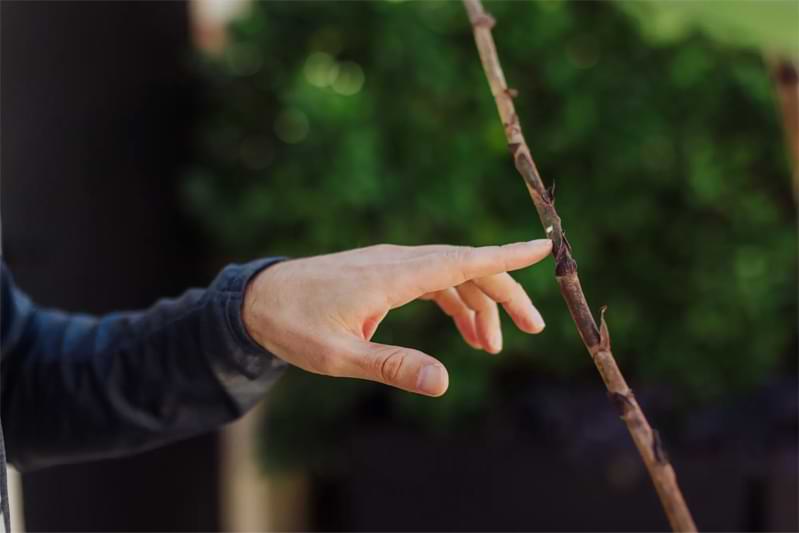
I trimmed the long, barren limbs down, and was happy to see sap come oozing out. The sunburned fiddle leaf fig is alive!
I used the Propagation Promoter on the edges of the cuttings, hoping to send a signal to the tree to encourage new growth.
The two limbs with surviving leaves went into water, with a dose of Propagation Promoter to see if they’ll sprout new roots and become their own new mini trees. I used a teaspoon of the Propagation Promoter in 2 cups of water. A little seems to go a long way.



While the damage was done in a few short days, I know the rehab process will take many months.
I’m optimistic about the tree’s survival, and excited to see its progress!
I’m hoping to update this post before my mother-in-law’s next birthday… when I *might* re-gift her the same tree… or maybe one its offspring! And this time, if it all works out, I’ll help find another “perfect spot” for a fiddle in her house.
We are so happy that Jared was able to save this tree and begin its long rehabilitation journey. This story of a sunburned fiddle leaf fig is a good learning lesson for all plant loves.
Signs of a Sunburned Fiddle Leaf Fig
There are a few things to look out for when it comes to your sunburned fiddle leaf fig. The most common sign of a sunburned fiddle leaf fig is the browning and drying of the leaves, followed by leaf drop. This will typically be one of the first signs to look out for, so when you notice it, it’s important to take action quickly.
This post has a bit more information on how to care for your Fiddle Leaf Fig if all it has is some brown spots on the leaves.
Other signs that your Fiddle is getting too much sun include: white spots on the leaves, texture changes on the leaves, and bleached leaves. If you see any of these signs on your FLF, take action sooner rather than later to give your plant the best chance at recovering.
Steps to Rehab a Fiddle Leaf Fig from Sunburn
- Remove your FLF from the light source. Your tree is going to need a limited amount of filtered sunlight for the next couple of weeks, and then you can return it to a spot that receives only indirect sunlight for up to 5 hours per day.
- Give your tree a good, thorough watering. For damaged trees, the best way to water them is from the bottom. To do this, fill a bucket or large container with water, and place your tree in its container with drainage holes in the water, allowing it to “drink” as much water as the soil will take up. Leave it in the water for around 15 minutes, and then let the excess water drain for another 15 minutes. If your tree is too large to lift, watering the soil from the top is fine. Just make sure to give it plenty of water.
- Inspect the damage and remove any severely damaged leaves. Check each individual leaf before pruning it off. If more than half of the leaf is still green, leave it on so your tree can continue using that leaf. If over half of the leaf is brown and crispy, you can carefully prune it off using sharp pruning shears. Once your tree recovers and begins growing new leaves reliably, you can start removing all of the previously damaged leaves.
- You can attempt to take cuttings for propagating new trees at this point. With damaged trees, many people decide to start over with new cuttings. To do this, simply take a 6-inch cutting of the healthiest-looking limb, dip the cut end in rooting hormone and place it in a fresh pot of clean potting soil or in a vase filled with water. You can also mix the rooting hormone/propagation promoter into the water as Jared has done. This is a great time to turn your cutting into a Fiddle Leaf Fig bush instead of a tall tree!
- If you’re not taking cuttings for propagation, use the propagation promoter on the ends of the branches to signal your plant to grow in that area.
- Stay on top of any possible pest infestations and keep your plant on a regular watering schedule. Watering once a week is a good rule of thumb, but always check the moisture level of the soil before watering with a moisture meter. If there is still a lot of moisture in the soil, hold off for a few days before watering again.
We are so thankful for Jared and Matt for sharing the story and the photos of Jared’s beautiful Fiddle Leaf Fig, and we look forward to seeing how this tree recovers from getting too much Arizona sunlight.
You can follow Jared’s Detours on Instagram here.
These stunning photographs were taken by Matt Ehnes, of www.jaredsdetours.com.

